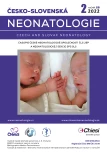Congenital toxoplasmosis as a part of neonatological care
Authors:
M. Geleneky
Authors‘ workplace:
Klinika infekčních nemocí, 3. LF UK a FN Bulovka, Praha
Published in:
Čes-slov Neonat 2022; 28 (2): 117-120.
Category:
Reviews
Overview
Congenital toxoplasmosis is a less common, but even more serious part of neonatology. It is a preventable disease, yet increasingly manifested in a symptomatic form, significantly affecting especially the CNS and senses. The prognosis is based mainly on the gestational age of the fetus at the time of maternal infection, early diagnosis and the time of initiation of prenatal or postnatal therapy. The neonatologist represents a very important place in this chain, especially for the possibility of early diagnosis of this disease, which often manifests itself for the first time in the first days or weeks after birth. The work discusses current knowledge about the prevention, diagnosis, clinical findings and treatment of congenital toxoplasmosis, with an emphasis on the role of neonatologists in this process.
Keywords:
prevention – congenital toxoplasmosis – TORCH infection – fetal infection – postnatal treatment
Sources
1. Faure Bardon V, Ville Y. Maternal infections: revisiting the need for screening in pregnancy, BJOG 2021; 128(2): 304−315. doi. org/10.1111/1471-0528.16509
2. Geleneky M, Prášil P, Kodym P. Doporučený postup pro diagnostiku a léčbu toxoplazmózy. Neonatologické listy 2019; 25(2): 18−30.
3. Pomares Ch, Montoya JG. Laboratory diagnosis of congenital toxoplasmosis. Ed. C. S. Kraft. Journal of Clinical Microbiology 2016; 2448–2454.
4. Rabilloud M, Wallon M, Peyron F. In utero and at birth diagnosis of congenital toxoplasmosis: use of likelihood ratios for clinical management. Pediatr Infect Dis J 2010; 29: 421.
5. Wallon M, Peyron F. Effect of antenatal treatment on the severity of congenital toxoplasmosis. Clin Infect Dis 2016; 62(6): 811−812. doi: 10.1093/cid/civ1035.
6. Singh S. Congenital toxoplasmosis: clinical features, outcomes, treatment, and prevention. Trop Parasitol 2016; 6: 113−22.
7. Peyron F. Maternal and congenital toxoplasmosis: diagnosis and treatment recommendations of a french multidisciplinary working group. Pathogens 2019; 8: 24. doi:10.3390/pathogens8010024
8. Mandelbrot L, Kieffer F, Sitta R, Laurichesse-Delmas H, Winer N, Mesnard L, Berrebi A, Le Bouar G, Bory JP, Cordier AG, et al. Prenatal therapy with pyrimethamine + sulfadiazine versus spiramycin to reduce placental transmission of toxoplasmosis: a multicenter, randomized trial. Am J Obstet Gynecol 2018; 4: 386.e1–386.e9.
9. The center for food security and public health. Toxoplasmosis (updated 2017). Available at http://www.cfsph.iastate.edu/ Factsheets/pdfs/toxoplasmosis.pdf
10. CDC. Parasites – Toxoplasmosis (Toxoplasma infection) (updated 2018). Available at https://www.cdc.gov
11. Thiébaut R, Leproust S, Chêne G, Gilbert R (SYROCOT study group). Effectiveness of prenatal treatment for congenital toxoplasmosis: a meta-analysis of individual patients’ data. Lancet 2007; 369: 115–122.
Labels
NeonatologyArticle was published in
Czech and Slovak Neonatology

2022 Issue 2
Most read in this issue
- Hyperbilirubinemia – time for change?
- Screening of the neonatal glycemia and its pitfalls
- Streptococcus agalactiae infections in a newborn
- Congenital toxoplasmosis as a part of neonatological care
